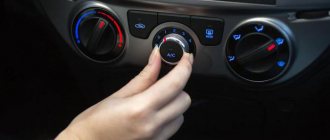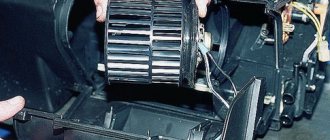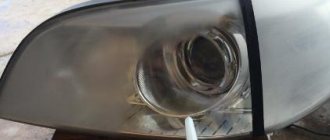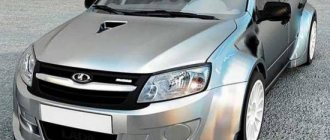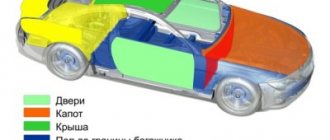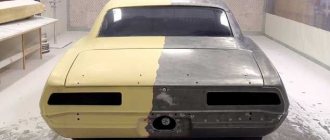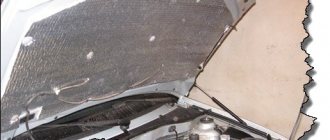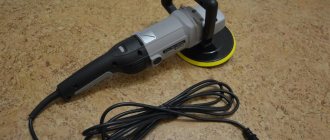Where does this come from?
Vibration is a consequence of the action of centrifugal forces - a certain imbalance between the rotating components of the car - for example, between the engine flywheel and the crankshaft, a heater or radiator fan, drums and brake discs, a large difference in mass between the engine connecting rods and the piston system.
But what can cause car vibration or, in other words, imbalance?
There are several of them:
- Technological reasons. They are most often caused by various deviations in the parameters and dimensions of parts.
- Design reasons are caused by the characteristics of a particular part. For example, on each of the wheels of a car there is a valve, which creates (albeit insignificant) deflection.
- Operational reasons are most often caused by severe deformation or wear of parts.
Damage to the internal parts of the hinge, which caused vibration, and this in turn led to the rupture of the engine mount.
Wheel alignment and tire quality
The appearance of vibration can also be associated with an incorrect wheel alignment angle. In this case, the car may pull to one side and the tires will wear unevenly, leading to costs associated with tire replacement.
These problems can be resolved in different ways.
First you need to adjust the wheel using wheel alignment. It may turn out that the disk itself is damaged due to a strong impact. After replacing or repairing it, the vibration will disappear.
Do not forget that after all these procedures, wheel balancing is necessary. Unfortunately, many car enthusiasts neglect it.
The above breakdowns are classified as easily removable and inexpensive, so it’s worth starting diagnostics by identifying them.
If this does not help, and the vibration in the body and wheels continues, we will deal with the problem further.
Balancing - as a way to eliminate vibration
Of course, balancing does not always eliminate shaking in the cabin, but sometimes these measures can reduce vibrations to a minimum. This is done by balancing the “problem” part.
To begin with, the heaviest side is found and the lighter side is weighted. If everything is done correctly, vibration is eliminated.
In this case, the balancing process itself is often carried out in several main ways:
- Dynamic method . Effective for eliminating vibration in almost any part. Its peculiarity is the forced rotation of the part using special equipment.
- Static method . Does not imply forced rotation. It is also simpler in that it does not require the use of expensive equipment - all the work can be done in a garage. Disadvantages include a limited selection of parts that can be tested and low accuracy.
If you choose from the two options proposed above, then the dynamic method looks more preferable, because it is more universal and all the necessary parameters can be seen on the computer.
In the static method, all work is carried out exclusively experimentally - drilling, attaching additional weights, removing excess material, and so on.
Speed
This is 800-1000 rpm. If the number of crankshaft revolutions is lower, the engine will begin to stall; with a higher number, fuel consumption will increase and engine parts will wear out faster. It is worth noting here that in the cold season, slight vibration after start is a normal phenomenon, which disappears after 5 minutes as the power plant warms up. If the engine shaking does not disappear, it is necessary to consider the reasons for its occurrence.
When should a car enthusiast be concerned about vibration levels?
By the way, it is not always clear when it is necessary to take some measures and go to a service station. Vibration is present in most cars. But how to determine which level is acceptable and which is not?
Again, the car enthusiast does not have any special instruments at hand to determine vibration, so he has to proceed from his own feelings.
Initial parameters for checking for shaking: the car is stationary, the gearshift knob is in neutral, the clutch is engaged, and the gas is added very smoothly.
Essentially, the vibration of the car at idle is checked. Is everything done? –
It is necessary to fix the problem if:
- when objects lying on the dashboard begin to move spontaneously and fall to the floor;
- a strong vibration is clearly felt on the steering wheel even with a light touch;
- The image in the rearview mirror is very difficult to catch - it becomes blurred due to strong rattling.
Danger of vibrations
The causes of vibrations that occur must be eliminated as soon as possible after the first signs of problems occur. This is explained by the fact that after vibrations, other problems often develop that can cause enormous damage to your vehicle. As experts themselves note, the greatest damage due to vibrations is caused to the car body. The first to wear out and break are the plastic elements, then gradually all sorts of fastenings, located sometimes in very hard-to-reach places, become loose. When the car shakes for a long time, the paint layer may begin to deteriorate. This already entails the formation of corrosion and the spread of rust throughout the body.
We must not forget about the harm that is caused to the power unit. The engine also suffers significantly from unnecessary vibrations. Vibration causes accelerated wear of parts, destroys the packing in the crankshaft, and then oil begins to leak. As a result, the engine cannot produce the required number of revolutions, the car accelerates more slowly, and fuel consumption increases significantly. And at the same time, engine power decreases, which negatively affects control. If you noticed that the car began to vibrate, but were able to find the reasons and eliminate them, the work is not yet completed. In addition to this, be sure to check all the parts that could have been damaged in any way as a result of the vibrations that have arisen. You can eliminate the source of vibration, but you cannot exclude the fact that some destructive processes have already been launched. The fastener has come loose, the paintwork has been damaged, and therefore new problems will potentially arise soon.
How to identify the source of vibration
Determining the source of vibration is a very difficult issue. To begin with, a car enthusiast must understand when vibration occurs - in a moving or stationary car.
In addition, it is necessary to analyze when the vibration appeared. Perhaps repair work was only recently carried out at a service station, or this phenomenon was noticeable from the very first days of purchasing the car.
The first thing you should pay attention to is engine performance. Vibration in the cabin is often felt precisely because of incorrect settings of the “heart” of the car.
To analyze this moment, it is necessary to observe the operation of the engine at idle - how “smoothly” it runs, whether there are periodic “fall asleep” and “bursts”.
To make the check more effective, you can call a friend to help you. In this case, one will observe the vibration in the cabin, and the second will carefully inspect the engine compartment.
Axle problems
If your vehicle has recently had a collision or other accident, an axle may have been bent or damaged. In this case, please note that vibration in the car occurs when accelerating.
Closely related in this context is the issue of the driveshaft, the mechanical component that transfers engine power to the rear or front axle (depending on whether you're driving a rear-wheel drive or front-wheel drive vehicle).
If you feel like the car is bouncing up and down the front (on FWD vehicles) and you notice a vibration and cracking noise coming from this part, you may be dealing with a worn or broken constant speed joint (CV joint). The solution is to repair and install the CV joints or replace the driveshaft entirely.
That being said, if your car bounces up and down in the rear (on RWD vehicles) and you notice that the vibration gets worse as you decelerate at high speeds, you may be dealing with worn universal joints (U segments) on the drive shaft. In this case, it is necessary to replace either the (V) joints or the entire driveshaft.
Safety precautions when detecting vibration
When identifying the source of increased vibration, you must always remember the possible danger. To avoid burns and injuries, you must follow these recommendations:
- firstly, when probing the most suspicious areas, it is advisable not to touch very hot areas, otherwise a severe burn is inevitable;
- secondly, when hanging a car, it is advisable to place it on reliable supports;
- thirdly, if testing is carried out on roads with a flow of other cars, it is necessary to act in such a way as not to disturb anyone.
Signs of Engine Vibration
On premium cars, especially if they have a multi-cylinder internal combustion engine, vibrations may not be felt on the body. All supports, fastenings, cushions are made of high quality material. In this regard, even turning off one cylinder does not particularly cause vibrations on other components. The engine seems to be isolated from the rest of the car.
Especially at idle, engine vibration affects the body of domestically produced cars. Also, in foreign-made cars with 4-cylinder engines, the impact on other components is felt.
Thus, the imbalance is always transmitted to the body and the gearbox handle. Let's look at how to identify and eliminate vibrations in engine components on a car with your own hands.
How to search for a vibration location
To be more likely to find the source of vehicle vibration, you must proceed in the following sequence:
- First , inspect the engine, exhaust system, and suspension with it turned off and then on.
- It happens that the engine protection is installed in close proximity to the unit itself and touches it. Such contact often produces strong vibration;
- Secondly , it is necessary to check the threaded connections, as well as the quality of drawing of all screws. It happens that only this work is enough to eliminate vibration;
- Thirdly , you need to turn off the fan. This will eliminate it from the list of possible “culprits” of vibration. If this particular unit is faulty, it can always be replaced;
- Fourth , depress the clutch and put the gearshift knob in neutral. If the problem persists, then one of the reasons may be the clutch basket, flywheel, crankshaft or automatic transmission parts.
There are situations when vibration occurs only during movement. In this case, problems with the chassis or transmission may be the cause.
Also, the cause of vibration in the steering wheel may be incorrect wheel alignment. Check whether the latest ones are installed correctly on the car.
If vibration occurs only when braking, then the likely cause is drums, discs or hubs.
In a situation where the car shakes even at low speed, wheel imbalance may occur. To verify your assumptions, you can swap the wheels.
The cardan can also act as a source of vibration, but here the vibration frequency is much higher than in the case of drums or disks.
The search for the cause of car vibration should be carried out both in a static position of the car and in motion. At the same time, we must not forget about checking the quality of vibration isolators.
Often, replacing them is enough to solve the problem. In practice, even the appearance of a crack, hardening or aging can lead to vibrations.
Causes of body vibration on a car
Vibrations when driving a car on a flat road usually arise due to critical wear of parts , violation of their geometry, loose and worn fasteners. The most common situations and their corresponding faults are presented in the table below.
| Situation | Most likely causes | |
| The car vibrates when accelerating hard |
| |
| The car shakes when braking hard |
| |
| The car vibrates at speeds of 40-60 km/h |
| |
| Vibrations in the car at speeds of 60-80 km/h | Everything from the point above, plus:
| |
| The car shakes at speeds over 100 km/h | All of the two previous points, and also: Violation of the aerodynamics of the car (body elements are damaged or non-standard ones are installed). | |
| The car shakes at speed when turning | Vibration when turning the steering wheel, accompanied by a crunching sound | Wear of CV joints. |
| Together with the knock | Wear of steering elements (tie rod ends, steering rack) and ball joints. | |
The imbalance that causes vibration and extraneous sounds can lead to increased stress on the associated components. For example, when wheels are unbalanced tires and suspension elements wear out faster. Vibrations also affect driving safety - the driver gets tired faster, and it is more difficult for him to keep the car on the road .
Some of the problems may at some point lead to complete loss of control. Therefore, it is extremely important to immediately determine the source of problems during diagnosis.
Timing timing mark offset
A mismatch between the marks located on the camshaft sprocket and the engine cover leads to disruption of the stability of the fuel supply and combustion process in the cylinders. The timing of ignition of the fuel mixture is also disrupted, and it may not burn completely or too early.
The marks may be set incorrectly by a person, for example, after carrying out any repair work affecting the fuel system and gas distribution system. They can also go astray on their own, namely due to stretching, damage to the timing belt (or improper tension).
Transmission malfunction
A more serious problem can also cause your car to vibrate. For example, a faulty gearbox.
An additional way to diagnose this problem may be a number of other symptoms. For example, difficulties with turning on any speed or its constant loss.
With automatic transmissions, the faulty transmission will “kick” or jerk the car when shifting to the next gear. Driving with such a malfunction is dangerous, since the unit may fail while driving and then the car will have to be removed by a tow truck.
Unreliable wheel mounts
This problem is also easy to fix and diagnose. This is a simple but very dangerous reason. The fastenings can be loosened even on one wheel, and this is enough to cause shaking. If the problem is not resolved in time, emergency situations may occur. If the wheel comes off while driving, the repair will be quite expensive - you will have to replace the disk and hub,
The symptoms in this case are very similar to vibrations due to tires or bent wheels. But there is a cyclical pattern here, although not at all speeds.


